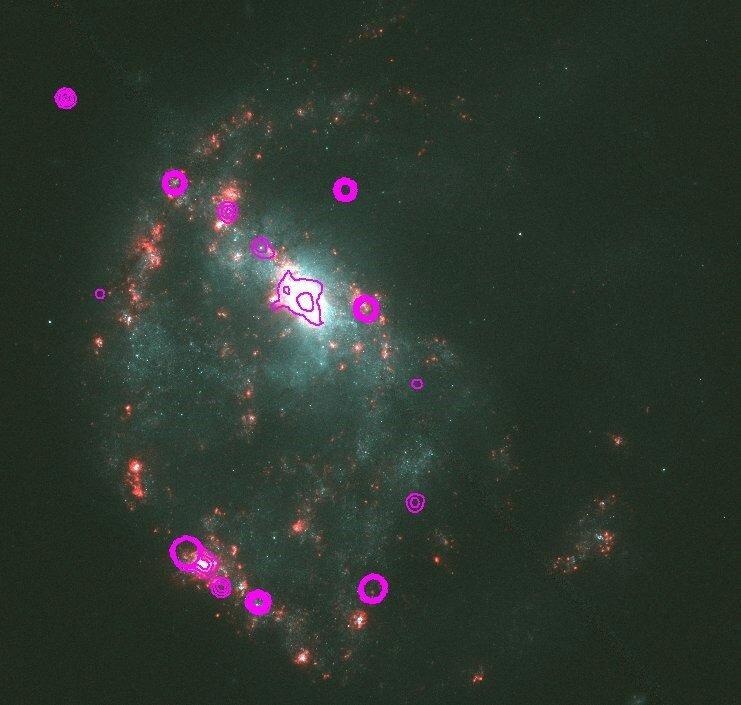Jun 24 2021
A new study offers new perceptions into the link between the X-ray luminosity of accreting black holes and neutron stars and the composition of the stellar populations that they are connected with.
 Α Hubble Space Telescope image of the galaxy NGC 922, showing the regions with intense star formation (red color). The purple contours show the X-ray emission, based on observations with the Chandra X-ray Observatory. The location of the bright ULXs is indicated by the circles, that occupy regions of intense star-forming activity. By using spectroscopic data from the ESO telescopes this work shows for the first time that there are significant variations in the metallicity (i.e. the number of elements heavier than hydrogen and helium) between different regions of this galaxy. Furthermore, these data combined with observations from the Hubble Space Telescope showed that the same regions, despite their different metallicity, host young stellar populations of very similar ages. The stars are just born: they are younger than ~10 million years. Image Credit: FORTH.
Α Hubble Space Telescope image of the galaxy NGC 922, showing the regions with intense star formation (red color). The purple contours show the X-ray emission, based on observations with the Chandra X-ray Observatory. The location of the bright ULXs is indicated by the circles, that occupy regions of intense star-forming activity. By using spectroscopic data from the ESO telescopes this work shows for the first time that there are significant variations in the metallicity (i.e. the number of elements heavier than hydrogen and helium) between different regions of this galaxy. Furthermore, these data combined with observations from the Hubble Space Telescope showed that the same regions, despite their different metallicity, host young stellar populations of very similar ages. The stars are just born: they are younger than ~10 million years. Image Credit: FORTH.
This study was performed at the Institute of Astrophysics of FORTH and the University of Crete.
Performed under the guidance of Dr. Kostas Kouroumpatzakis, from the Institute of Astrophysics at the Foundation for Research and Technology, Hellas (IA-FORTH), and the University of Crete, the study was recently reported in the journal Monthly Notices of the Royal Astronomical Society.
For the very first time, this study demonstrated that various regions of a galaxy possess highly different amounts of metals while hosting young stellar populations of quite similar ages. But the main result is that metal-poor regions exhibit higher X-ray luminosity.
This study concentrates on NGC922, a so-called “ring galaxy” present in the vicinity, which features a magnificent ring of stars and gas developed following the head-on collision between a dwarf and a bigger spiral galaxy. The stars generated by the encounter have virtually the same age, enabling people to examine the development rate of stellar remnants like neutron stars and back holes.
The key result from this work, however, comes from the X-ray emission in these regions as measured with the Chandra X-ray Observatory, which probes the black-hole and neutron-star populations left after the massive stars end their lives, often found in binary stellar systems. The regions with lower metallicity have higher X-ray luminosity.
Dr Kostas Kouroumpatzakis, Institute of Astrophysics, Foundation for Research and Technology, Hellas
Indeed, a few of these regions host several Ultraluminous X-ray sources, which are enigmatic sources that generate luminosities surpassing by far the normal luminosity of accreting black holes and neutron stars (generally called X-ray binaries) seen in the Milky Way.
A similar fashion has been noticed during the comparison of various galaxies, but this is the first time that it has been quantified inside the same galaxy. Therefore, it is possible to unambiguously unravel the role of metallicity from the impact of the age of stellar populations.
Such findings are of great significance for gaining better insights into the effect of metallicity in the development and evolution of X-ray binary systems.
This is a very active area of study because it provides crucial information for the formation of binary systems of massive stellar remnants such as those producing gravitational wave events, and because X-ray binary systems may have played an important role in the early Universe (when it was only ~3% of its current age) affecting the subsequent formation of galaxies.
Dr Kostas Kouroumpatzakis, Institute of Astrophysics, Foundation for Research and Technology, Hellas
This study was carried out at the IA-FORTH and the University of Crete (UoC) by Dr. Kostas Kouroumpatzakis, who completed his PhD recently, and UoC Professor Andreas Zezas (affiliated researcher, Institute of Astrophysics), together with Dr. Anna Wolter (INAF-Brera), Dr. Antonella Fruscione (Center for Astrophysics, Harvard and Smithsonian), Dr. Konstantina Anastasopoulou (INAF-Brera) and Dr Andrea Prestwich (Center for Astrophysics, Harvard and Smithsonian).
This study integrated data for the nearby galaxy named NGC922 from NASA’s Chandra X-ray observatory (X-ray data), the Hubble Space Telescope (optical imaging), the Wide-Field Infrared Survey Explorer (WISE; infrared) and the New-Technology Telescope (NTT) of the European Southern Observatory (ESO; optical spectra).
The study was financially supported by the European Research Council and the Marie Skłodowska-Curie RISE Action.
Journal Reference:
Kouroumpatzakis, K., et al. (2021) Metallicity and X-ray luminosity variations in NGC 922. Monthly Notices of the Royal Astronomical Society. doi.org/10.1093/mnras/staa3290.